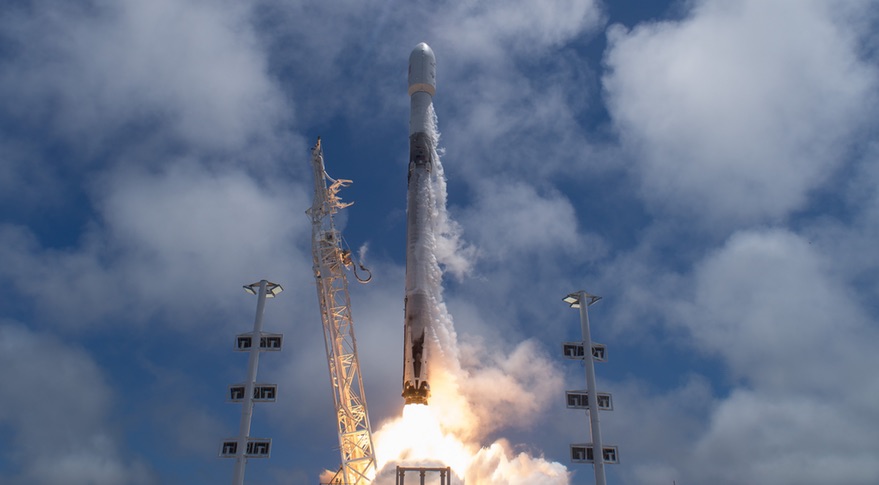Air Force Open to Reusable Rockets, but SpaceX Must First Demonstrate Performance
WASHINGTON — SpaceX in its first national security launch for the U.S. Air Force will not attempt to land the first stage of the Falcon 9 rocket. The Block 5 version of the vehicle scheduled to lift a GPS 3 satellite on Dec. 23 is an expendable rocket with no legs or grid fins.
The Air Force decided that only an expendable rocket could meet "mission performance requirements," said Walter Lauderdale, mission director of the Air Force Space and Missile Systems Center's Launch Enterprise Systems Directorate.
A number of factors led to this decision, including the mission trajectory and payload weight. "There simply was not performance reserved to meet our requirements and allow them, for this mission, to bring the first stage back," Lauderdale said Dec. 14 in a conference call with reporters. [See the Evolution of SpaceX's Rockets in Pictures]
Lauderdale during the call mentioned the word "uncertainty" several times to underscore the Air Force's thinking about reusable rockets and about working with a new launch provider.

Lauderdale insisted that the Air Force will need time to review SpaceX's performance as it executes these missions before it would consider flying military payloads on reusable rockets. The Air Force will not compromise performance or reliability, he said. "We have to ensure the rocket performs safety and accurately." The $529 million GPS 3 payload is "precious cargo."
The satellite is the first of 10 GPS 3 vehicles the Air Force plans to put into orbit in the coming years. The spacecraft, made by Lockheed Martin, will broadcast more secure and more accurate signals than the current GPS satellites. Once the new satellite reaches orbit and completes up to 18 months of tests, it will replace an aging GPS satellite that has been in service since 1997.
Lauderdale said the Air Force will wait to see what happens in this first launch and study the data before it can engage in any discussions about reusability.
Get the Space.com Newsletter
Breaking space news, the latest updates on rocket launches, skywatching events and more!
"We are continuing to look at this as we try to drive down uncertainty," he said. "As we work through this first flight together, we will look at the performance, do all the calculations and analysis so we can continue to look for opportunities in the future."
Lauderdale said he could not predict if and when SpaceX would be allowed to fly a reusable Falcon 9 for a GPS launch. "I don't want to commit to a particular mission but, fundamentally, we need to work through the uncertainty, analyze the performance," he said. "We're getting flight experience with SpaceX, and that removes uncertainty, gives us more confidence in what performance the vehicle can deliver. We'll continue to work as partners to see what's possible in the future."
In this first flight, the focus is on performance and safety, said Lauderdale. "After we see the performance of the Falcon 9 we are going to refine our analysis and look if we can get performance back that would enable SpaceX to recover their booster," he added. 'It's an ongoing project."
After the Tuesday launch, he said, "We're going to analyze the results." One way or the other, he added, "We're not going to compromise the requirements that we need to deliver our spacecraft. But as we become more confident, as we get more data to support our assessments, we can always revisit, see the art of the possible. But we're not going to do it without having confidence that we can deliver the spacecraft safely to orbit."
Safety practices under scrutiny
SpaceX's first key test as a national security launch provider comes in the wake of revelations that NASA initiated a review of the company's safety practices, presumably prompted by the recent behavior of SpaceX founder Elon Musk.
Col. Robert Bongiovi, director of the SMC Launch Enterprise Systems Directorate, said the Air Force has no issues with the company's safety culture. "We have a standard of 100 percent mission success and a robust mission assurance process," he said. "We have worked hand in hand with SpaceX to review the design of the Falcon 9," he told reporters. "We very much understand their mission success processes. We absolutely did not have a concern about their process. … A key part of mission assurance is understanding what's happening in testing, and making sure no issues cross over to this launch."
The Air Force, however, has not determined when it might allow reused hardware instead of brand-new Block 5 rockets. "We intend to certify flown vehicles," he said. SMC is working with SpaceX "to understand what's different and what do we have to watch out for," he added. "SpaceX has a lot of experience doing this. We are working with them to help us put together a plan so we can learn as well."
SMC officials said they would wait and see how pre-flown first stages performed in commercial launches before they decide if they are suitable for national security missions. Gen. John Raymond, commander of Air Force Space Command, told Bloomberg News in October 2017 that the Air Force would be "absolutely foolish" not to utilize SpaceX's reused rockets in order to take advantage of the cost savings.
This story was provided by SpaceNews, dedicated to covering all aspects of the space industry.
Join our Space Forums to keep talking space on the latest missions, night sky and more! And if you have a news tip, correction or comment, let us know at: community@space.com.

Sandra Erwin covers the military and national security beat as a Senior Staff Writer at SpaceNews. Sandra, based in Arlington, Virginia, specializes in Defense Department and Intelligence Community space programs, policy, budgets, technology and the industry that supports this sector. She joined SpaceNews in October 2017. Before coming to SpaceNews, Erwin covered the U.S. military, the Pentagon, Congress and the defense industry for over two decades as editor of the National Defense Industrial Association's National Defense Magazine and Pentagon correspondent for Real Clear Defense.










